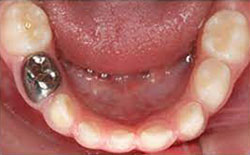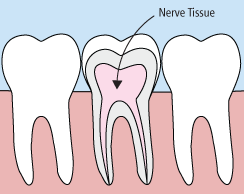Topics on this page

Regular Exams and Cleanings
Regular exams are an important part of maintaining your child's oral health. In combination with brushing and flossing at home, visiting the dentist for a comprehensive exam and cleaning is essential. The American Dental Association recommends that your child visit the dentist every six months to ensure a healthy smile. During your child’s exam, we will:
- Perform a thorough teeth cleaning, polish, and rinse the teeth to remove any tartar and plaque that have built up on the tooth's surface.
- Examine your child's teeth and gums for signs of tooth decay, gum disease, and other health problems.
- Take X-rays to identify any dental issues not visible to the naked eye.
Visiting our office every six months gives you the chance to talk to the doctor about any questions you may have about your child’s oral health.
Fluoride

Fluoride is effective in preventing cavities and plaque from building up and hardening on the tooth’s surface. A fluoride treatment in a dentist’s office takes just a few minutes. After the treatment, your child may be asked not to rinse, eat, or drink for at least 30 minutes in order to allow the teeth to absorb the fluoride. Depending on your child’s oral health or the doctor’s recommendation, a fluoride treatment may be required every three, six, or 12 months.
Sealants
Sometimes brushing is not enough, especially when it comes to those hard-to-reach spots in your child’s mouth. It is difficult for a toothbrush to get in between the small cracks and grooves on your child’s teeth. If left alone, those tiny areas can develop tooth decay. Sealants give your child’s teeth extra protection against decay and help prevent cavities and staining.
Sealants are a plastic resin that is painted on the chewing surfaces of the teeth. When a tooth is sealed, the tiny grooves become smooth and are less likely to harbor plaque. With sealants, brushing your child's teeth becomes easier and more effective against tooth decay.
Sealants are typically applied to children’s teeth as a preventive measure against tooth decay after the permanent teeth have erupted. It is more common to seal “permanent” teeth rather than “baby” teeth, but every patient has unique needs, and your child’s dentist will recommend sealants on a case-by-case basis.
Silver Diamine Fluoride
Silver Diamine Fluoride (SDF) is a simple and noninvasive way to prevent the spread of cavities. We recommend using SDF in certain situations such as, young children that might have difficulty sitting still for treatment. SDF will be applied to any decayed areas of the teeth.
It is important to note that any decayed areas will stain black. Any healthy tooth structure will not stain as the medication only affects areas of decay.
Advantages of Silver Diamine Fluoride include:
- Immediate relief from tooth hypersensitivity
- The killing of organisms that cause cavities
- Hardening of softened tooth structure making the tooth more resistant to acids and abrasions
Disadvantages of Silver Diamine Fluoride include:
- The areas treated with SDF will turn black which can be an aesthetic issue, especially for front teeth. It is important to note that the dark staining is still very apparent even after a white filling is completed.
- SDF is often not a definitive treatment so further treatment of the affected tooth is often required.
- SDF is often not very effective for the treatment of large cavities that are near the nerve, nor is it effective for large cavities between the teeth.
Extractions
 There are times when it is necessary to remove a tooth. Sometimes a baby tooth has misshapen or long roots that prevent it from falling out as it should, and the tooth must be removed to make way for the permanent tooth to erupt. At other times, a tooth may have extensive decay that puts the surrounding teeth at risk of decay, so the doctor may recommend its removal. Infection, orthodontic correction, or problems with a wisdom tooth can also require removal of a tooth.
There are times when it is necessary to remove a tooth. Sometimes a baby tooth has misshapen or long roots that prevent it from falling out as it should, and the tooth must be removed to make way for the permanent tooth to erupt. At other times, a tooth may have extensive decay that puts the surrounding teeth at risk of decay, so the doctor may recommend its removal. Infection, orthodontic correction, or problems with a wisdom tooth can also require removal of a tooth.
When it is determined that a tooth needs to be removed, your child’s dentist may extract the tooth during a regular checkup or may request another visit for this procedure. In some cases, after removing primary molars, space maintainers will be needed to ensure adequate space for the permanent molar to erupt. See "Space Maintenance" for further information.
Space Maintenance
A space maintainer can be placed to reduce the chance of crowding when adult teeth fully erupt.
Types of Space Maintainers
The space maintainers we use are made of stainless steel and are fixed (cemented to the teeth).
Fixed space maintainers come in many designs.
Band & Loop (B&L)
A band-and-loop space maintainer is a stainless steel band that loops around the tooth and is held in place by a wire and rests against the side of the tooth on the other end of the space. A band & loop is routinely used to hold space for a missing primary posterior tooth (baby molar) until the permanent tooth has grown in. A band and loop can only be used if one tooth is missing in a quadrant. Your child's dentist will remove the band and loop once the appropriate adult molars have erupted.
Distal Shoe (DSSM)
In the case of a lost second primary molar prior to the eruption of the first permanent molar, a distal shoe may be recommended. Because the first permanent molar has not come in yet, there is no tooth to hold a band-and-loop space maintainer in place. A distal shoe appliance has a metal wire that is inserted slightly under the gum and will prevent the space from closing.
Lower Lingual Holding Arch (LLHA)
A lingual arch is used when multiple baby teeth are removed prematurely from the lower jaw. A wire is placed on the tongue side of the arch and is attached to the fully erupted permanent molars. This prevents the teeth from migrating and prevents them from blocking off the space of teeth that develop later.
Nance
A nance is used when multiple baby teeth are removed prematurely from the upper jaw. A wire is placed on the roof of your child's mouth and is attached to the fully erupted permanent molars. This prevents the teeth from migrating and prevents them from blocking off the space of teeth that develop later.
Fillings
 Composite resin fillings are often recommended for smaller areas of decay on primary or permanent teeth. This type of dental restoration provides a natural looking outcome and is often not noticeable to the eye. In some cases your child’s dentist will recommend a stainless steel crown instead of a filling due to the decay presenting much larger or insufficient tooth strength once the procedure has begun.
Composite resin fillings are often recommended for smaller areas of decay on primary or permanent teeth. This type of dental restoration provides a natural looking outcome and is often not noticeable to the eye. In some cases your child’s dentist will recommend a stainless steel crown instead of a filling due to the decay presenting much larger or insufficient tooth strength once the procedure has begun.
Crowns
Dental crowns are typically recommended for children who have dental injury such as a broken tooth or decay beyond repair. Even though baby teeth will fall out, restoring the tooth is crucial to ensure proper dental development.
A crown is a “cap” cemented onto an existing tooth that usually covers the portion of the tooth above the gum line. In effect, the crown becomes the tooth’s new outer surface. Pediatric crowns can be made of porcelain or metal.
Crowns are needed when there is insufficient tooth strength remaining to hold a filling. Unlike fillings, which apply the restorative material directly into the tooth, a crown is prefabricated. The crown is then adjusted just for your child so that his or her bite and jaw movements function normally once the crown is placed.
Stainless Steel Crowns
 Stainless steel dental crowns are considered a good restoration to save a primary tooth until the permanent tooth can erupt and take its place. A primary tooth can be restored with a stainless steel crown during one appointment.
Stainless steel dental crowns are considered a good restoration to save a primary tooth until the permanent tooth can erupt and take its place. A primary tooth can be restored with a stainless steel crown during one appointment.
The strength of the stainless steel crowns not only helps it last longer, it also means the crown can be thinner than a traditional crown and require less removal of the healthy tooth structure below it for placement. It is always best to keep as much natural tooth as possible, both for longevity of the crown and the tooth itself.
NuSmile® Crowns
We offer NuSmile Crowns for our patients needing front teeth restorations. NuSmile Crowns are designed in order to provide access to a strong, color-stable, and full-coverage option for the protection of the remaining tooth structure. In fact, the front surface of the crown is the color of actual teeth so the restoration does not stand out. There are many advantages associated with NuSmile Crowns; easy placing on the teeth, full protection and durability are just some of the qualities which make this a great choice for those who need dental work done.
Zirconia Crowns
Zirconia crowns provide a durable and aesthetically-pleasing option for addressing areas of decay in teeth, including primary teeth in children. Zirconia crowns are considered among the most effective dental restorative options from an aesthetic perspective. Zirconia crowns are recommended on a case by case basis so be sure to ask your child's dentist about this option at your appointment.
What to Expect When My Child's Crown is Placed
The first step to placing any dental crown is to remove any decayed tissue. Your child will receive local anesthetics to ensure they don’t feel any pain or discomfort while having their crown placed. Your child’s dentist will remove decayed tissue, and reshape the remaining healthy tissue. After the tooth has been prepared, the next step is to determine the correct size of dental crown. Once the proper-fitting crown has been determined, it will be permanently adhered to the surface of the tooth.
Post Operative Instructions PDF
Pulpotomy
What Is A Pulpotomy?
When the nerve or pulp tissue of a primary tooth is infected, and needs to be treated to prevent a dental abscess and loss of the tooth, a pulpotomy is a restorative technique used by pediatric dentists to save a severely decayed primary tooth wherein the decay has reached the inner layer of the tooth. It is similar to a root canal and is also commonly referred to as pulpotomy or a baby tooth nerve treatment. Pulp therapy involves removing the decayed tissue to prevent the loss of the tooth or the spread of infection.
It is possible for teeth to become infected due to oral trauma as well. If your child slips and falls and breaks or cracks a tooth, bacteria can enter the tooth and cause an infection. It is important to get emergency care if your child experiences an oral injury. Regardless of how the infection happens, the result is the same. Overtime, the bacteria will attack the inside the tooth and eventually cause irreversible damage to the tooth.
What To Expect During a Pulpotomy
Your child’s doctor will remove the infected and damaged portion of the pulp from the tooth and place a layer of medication that helps protect the remaining pulp from infection. After this, your child’s tooth will be protected with a stainless steel crown that will fall off with the tooth when it is time.
What Is The Difference Between A Pulpotomy And A Root Canal Treatment?
Although they may sound similar, there are actually a few key differences between a baby root canal (pulp therapy) and an adult root canal. First, permanent fillings are not placed in the nerve canal during a baby root canal. This is so that the tooth can naturally be lost when it is time. Secondly, decay spreads at a quicker rate in baby teeth than it does in adult teeth, therefore the need for pulp therapy can be greater than the need for an adult root canal.
Mouthguards
 Whether your child wears braces or not, protecting his or her smile while playing sports is essential. Mouthguards help protect the teeth and gums from injury. If your child participates in any kind of full-contact sport, the American Dental Association recommends that he or she wear a mouthguard. Choosing the right mouthguard is essential. There are three basic types of mouthguards: the pre-made mouthguard, the “boil-and-bite” fitted mouthguard, and a custom-made mouthguard from the dentist. Your dentist can show your child how to wear a mouthguard properly and how to choose the right mouthguard to protect his or her smile.
Whether your child wears braces or not, protecting his or her smile while playing sports is essential. Mouthguards help protect the teeth and gums from injury. If your child participates in any kind of full-contact sport, the American Dental Association recommends that he or she wear a mouthguard. Choosing the right mouthguard is essential. There are three basic types of mouthguards: the pre-made mouthguard, the “boil-and-bite” fitted mouthguard, and a custom-made mouthguard from the dentist. Your dentist can show your child how to wear a mouthguard properly and how to choose the right mouthguard to protect his or her smile.
Nightguards
There is an easy, non-invasive treatment for bruxism: nightguards. Nightguards are an easy way to prevent the wear and damage that teeth-grinding causes over time. Custom-made by a dentist from soft material to fit the teeth, a nightguard is inserted over your child’s top or bottom arch and prevents contact with the opposing teeth.


Follow Us